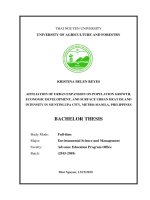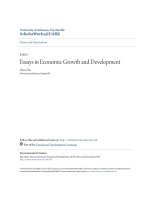Economic growth and economic development 709
Bạn đang xem bản rút gọn của tài liệu. Xem và tải ngay bản đầy đủ của tài liệu tại đây (60.86 KB, 1 trang )
Introduction to Modern Economic Growth
papers use the term directed technical change, but here we used the related term directed technological change, to emphasize continuity with the models of endogenous
technological change studied in the previous chapters. The framework presented
here builds on Acemoglu (2002a). A somewhat more general framework, with much
less functional form restrictions, is presented in Acemoglu (2007).
Other papers modeling the direction of technological change include Caselli and
Coleman (2004), Xu (2001), Gancia (2003), Thoenig and Verdier (2003), Ragot
(2003), Duranton (2004), Benabou (2005), and Jones (2005).
Models of directed technological change are closely related to the earlier literature
on induced innovation. The induced innovation literature was started indirectly by
Hicks, who in The Theory of Wages (1932), argued
“A change in the relative prices of the factors of production is itself
a spur to invention, and to invention of a particular kind–directed
to economizing the use of a factor which has become relatively
expensive.” (pp. 124-5).
Hicks’ reasoning, that technical change would attempt to economize on the more
expensive factor, was criticized by Salter (1960) who pointed out that there was no
particular reason for saving on the more expensive factor–firms would welcome all
cost reductions. Moreover, the concept of “more expensive factor” did not make
much sense, since all factors were supposed to be paid their marginal product. An
important paper by Kennedy (1964) introduced the concept of “innovation possibilities frontier” and argued that it is the form of this frontier–rather than the shape
of a given neoclassical production function–that determines the factor distribution
of income. Kennedy, furthermore, argued that induced innovations would push the
economy to an equilibrium with a constant relative factor share (see also Samuelson, 1965, and Drandakis and Phelps, 1965). Around the same time, Habakkuk
(1962) published his important treatise, American and British Technology in the
Nineteenth Century: the Search for Labor Saving Inventions, where he argued that
labor scarcity and the search for labor saving inventions were central determinants
of technological progress. The flavor of Habakkuk’s argument was one of induced
innovations: labor scarcity increased wages, which in turn encouraged labor-saving
695









